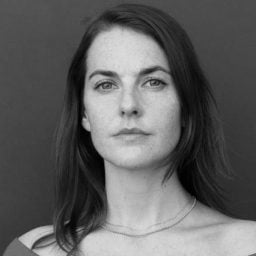Studio Visit
At the Neuendorf Residency in Mallorca, William Monk Embraces the Slowness of Painting
The artist set up a temporary studio at the minimalist retreat.
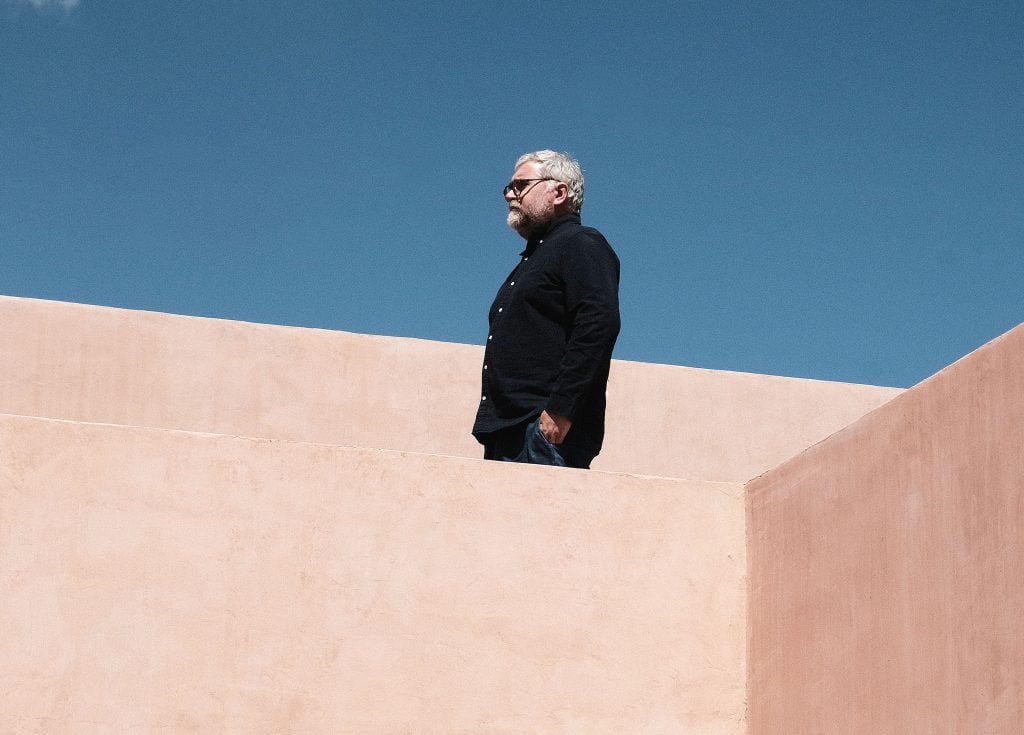
“I’m slow to absorb things,” William Monk told me as he wandered around his studio at the Neuendorf Residency in Mallorca, doubling down with an example of being unsure whether Jay-Z is pronounced zed or zee.
I laughed, somewhat in disbelief, and asked, “but if you had to pick one?” I’m still not sure if he’s joking when he pauses and opts for the former. As I weigh up whether or not it’s charming that such a cultural phenomenon could escape, well, anyone, I wonder if this supposed slowness is simultaneously part of Monk’s acumen as a painter.
Known for his large-scale oil paintings that often create a feeling of immersion through their installation, Monk renders worlds that are reminiscent of landscapes, which could be real or imagined and that draw you in. His are affecting spaces in which reality seems to have different potentialities, and where time, indeed, percolates with a certain slowness.
Monk develops series that gradually evolve over time, with repetition being a key aspect of his approach. Take, for example, the artist’s 2023 exhibition “West of Nowhere,” at Pace’s Los Angeles gallery, in which four paintings were installed to face one another, engaged in a conversation of near identical compositions. In each, six monoliths rise from a barren surround, multicolored and elongated formations echoing around the room. Son of Nowhere IV (2023) sees gentle blues and pinks amid the palest of oranges, humming against a pastel backdrop of rocks and sand.
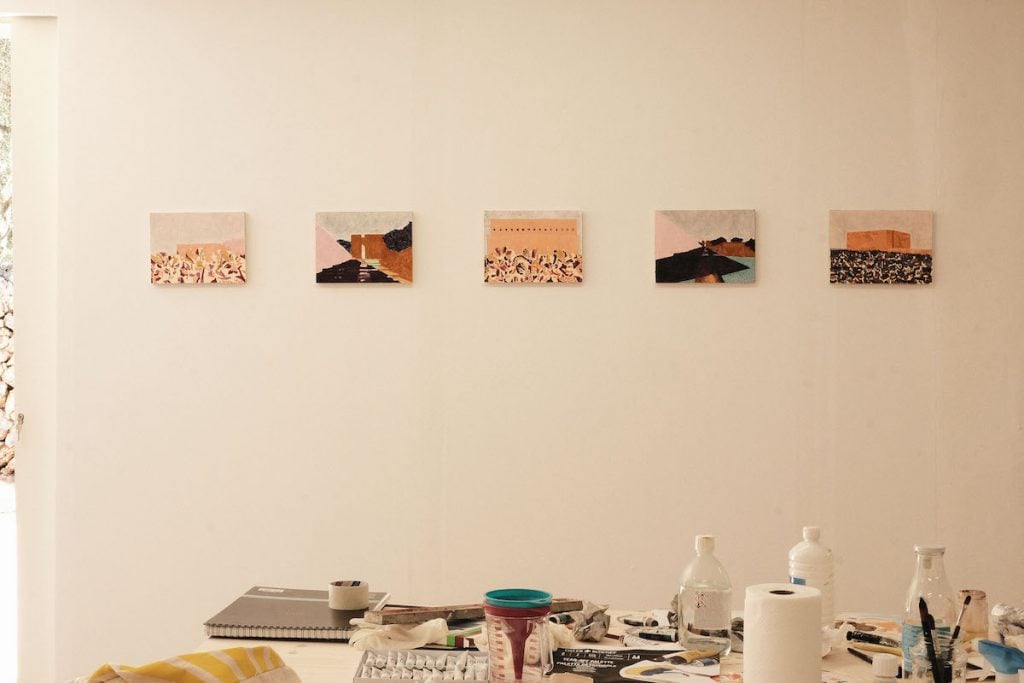
View of William Monk’s studio at the Neuendorf Residency in Mallorca.
The effect is otherworldly, and it’s easy to imagine entering the paintings, weaving your body through the columns of color, before going onto explore what may lie beyond the frame.
Monk emphasizes how, “with repetition, you start to pay attention to the variation: it gets big and amplifies the difference”. It is fitting to discuss the complexities that arise through recurrence within the context of the Neuendorf House—the location of Monk’s month-long residency—which is the definition of minimalist essentialism.
Designed by John Pawson and Claudio Silvestrin (the former known for converting a World War II bunker into the exhibition space of the Feuerle Collection in Berlin, and the latter responsible for the Fondazione Sandretto Re Rebaudengo in Turin), it was built from 1987 to 1989, and is all angles, lines, and planes, distilled to their most fundamental features.
Sometimes a building is also its own person, which can cocoon or overpower. It brings personality and exudes idiosyncratic energy. The Neuendorf House makes you aware of existing in relation to it, with the architecture also shaping your experience of the arid Mediterranean landscape that surrounds it. Everything here is color, in ever-changing expanses: a terracotta that is one tone shifts into something else entirely as the light changes. Its mottled surfaces are variegated against the block of blue sky above, which is cast as its own monochrome.
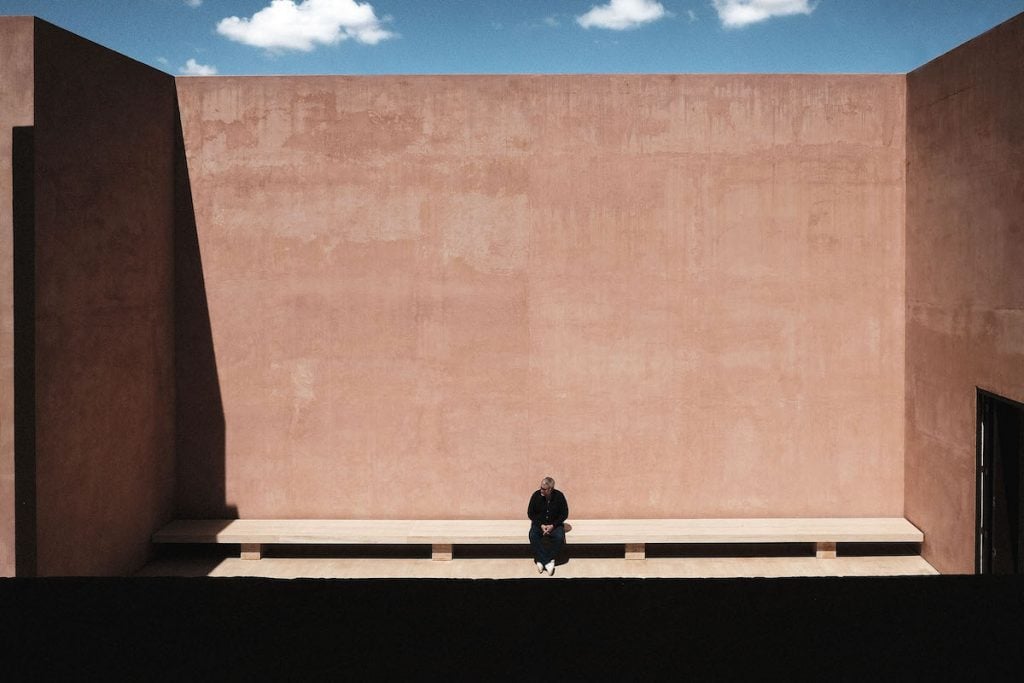
William Monk at the Neuendorf Residency in Mallorca.
As Monk said, “it’s reduction that allows for the expanse,” pondering whether it was Paul Cézanne or Henri Matisse who believed, “this amount of red is never as much as this amount of red”. He’s referring to Matisse’s remark that “a thimbleful of red is redder than a bucketful,” or in other words, less is more.
Wind howls as it blows through the house, and when it rains, the walls bleed, stained with rich trails of water. Inside, doors are their own monoliths; corridors are narrow, illuminated only by the skylights above. It’s like walking through the veins of the house. “The straight line doesn’t exist in nature, but this building is all the straightest of lines,” Monk stressed.
It was originally designed to have no windows at all, skylights alone spilling sunlight into whitewashed rooms. Instead, tiny cubes were carved into the walls, framing the vistas beyond like paintings, the sea visible at the horizon line.
Monk has long been inspired by the house, and has even considered asking the architects to design his new studio in Long Island. Born in 1977 in southwest London (I suppose we do say zed in the U.K., to be fair), Monk undertook a bachelor’s degree in fine art at Kingston University in the late 1990s before studying at De Ateliers in Amsterdam in the mid-2000s, where he was awarded the Dutch Royal Award for Painting in 2005. He was picked up by Grimm Gallery soon thereafter. Following stints living in Paris and London, he relocated his family to New York just before the first lockdowns in 2020, and has no plans to return to live in Europe.

A painting by William Monk displayed in the garden of the Neuendorf Residency in Mallorca.
At the Neuendorf Residency, his studio is nestled at the bottom of a garden burgeoning with cactus plants that double as sculptures. Monk is working on five small-scale, oil-on-panel paintings, as well as a series of gouache watercolors. The artist’s usual ground is raw canvas primed with rabbit-skin glue, onto which he builds up layers of color and patches of mark making, until they reach a point of resolution.
Monk describes his method as a kind of dialogue between him and the material: “When I’m putting down those first marks, which are just on the raw canvas, the line that I’ve drawn will travel a little bit through the warp and weft, and then it’ll stop. It’s a stroke that’s mine and also not mine.”
I catch only the briefest peek at the works in the Mallorca studio, but in one, pinks, purples, and greens jostle to depict a dark plane that is unmistakably the towering wall of the main courtyard at the Neuendorf House, a sharp angular shadow cast across the expanse. “The eye will track across a space and will only stop when there’s a point of contrast,” said Monk, who goes onto underline, “if there’s no contrast, your eyes will just keep moving. So I always think, when there’s that moment of contrast, let it be good.”
The painting has the subtlest notes of Giorgio de Chirico, flat surfaces offset with chiaroscuro. It is therefore no surprise to hear Monk musing on how “there’s a metaphysical atmosphere about this place, a sort of dreaminess, but it’s stark and reduced and essential. It’s a blank canvas for our imagination.”
Both mythology and classical antiquity are of interest to Monk, who is hoping to visit Pompeii for the first time in the near future. Yet unlike de Chirico, Monk’s sense of estrangement is evoked not through drastically receding perspectives or the symbology of objects, but as a result of implied passages: of death or transcendence.
He even installed his 2022 exhibition “The Ferryman” at Pace’s New York gallery to resemble the flow of rooms in a Roman house, moving from an antechamber into what could be a cloister or shrine rooms. Three large-scale round paintings hung from the ceiling: Nova (deadeye I, II, III) (all from 2022), which seemed at once to be dark portals with hazy pink surrounds, as well as all-knowing eyes. Monk told me, “I’ve got a new vision in my mind: I’m still thinking about the transient passage of death, but it’s looking a little bit more like the Medusa.”
I wonder where this Medusaesque passage might resurface and ask what’s next for the artist. He explained he’s spending a lot of time in Asia, having presented the exhibition “Psychopomp” at the Long Museum in Shanghai earlier this year, another iteration of which has just opened at the Sifang Art Museum in Nanjing, which runs through June 30. Monk will also have a monograph published by Phaidon.
Reflecting on the development of his own passage as a painter and the steadfastness of people who paint regardless of fashion and market tastes, Monk repeatedly references the so-called death of painting at around the turn of the millennium. He acknowledges artists like Marlene Dumas, Peter Doig, and Luc Tuymans, and is passionate in stressing, “it’s no surprise that the people who were painting in the 1990s, when painting was dead, were really good painters.”
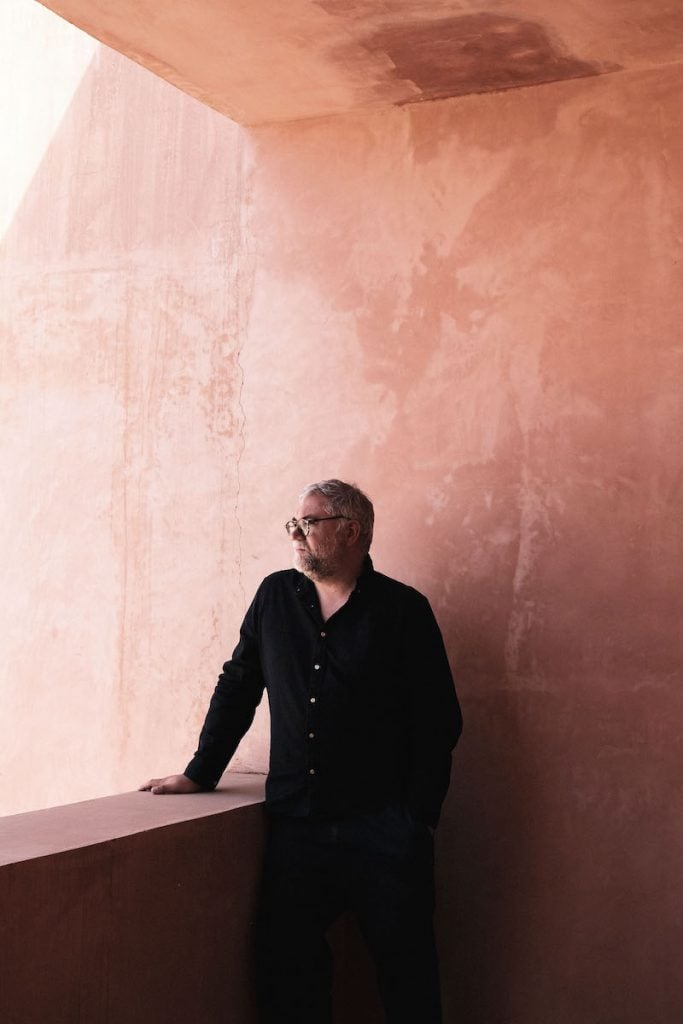
William Monk at the Neuendorf Residency in Mallorca.
The details of art historian Douglas Crimp’s polemic on the death of painting—a position that arose out of the context of 1980s neo-expressionism and was underpinned by Duchamp’s disdain for the aura of the artist’s touch and Walter Benjamin’s writings on art in the age of mechanical reproduction—are of less interest to Monk than his own focus on achieving difference as a painter. He believes that his perspective is unique to him—or, rather, that each person has their own perceptual make-up—and that the medium of paint can speak to an idiosyncratic reality.
Monk homes in on Cézanne to point out, “I suppose the existential aspect of it specifically is the way in which I might see color through light, which is different to how you or anyone else will see it.” For Monk, twentieth-century masters like Cézanne were “getting rid of anything derivative, so he’s left with only himself. The first thing I can do in that regard is not to make a painting in a way that other painters do.”
Monk clearly gravitates towards ideas of individualism in the path to originality, and while these may seem a little out of step with recent discourse on collectivism or rewriting histories, the distinctiveness of the Neuendorf House does make you feel—dare I say it—special, even if just for a moment. It reframes the normalcy of the day-to-day and reminds you to take wonder in the small things; that even subtle shifts in light can and do matter.
It is easy to tune into Pawson and Silvestrin’s aspirations in designing a house like this, and to imagine what that they might have said to one other in the process. To paraphrase Monk, that moment of contrast: let it be good.
Neuendorf Residency is run by Caroline Neuendorf and Artnet’s chief strategy officer, Albert Neuendorf.

